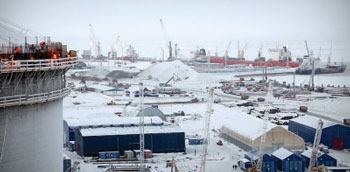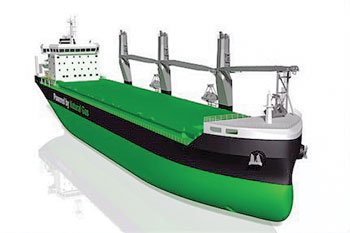New in gas processing technology
Compressor delivery for Russia’s Yamal LNG
 |
China National Offshore Oil Corp. (CNOOC) delivered the final LNG core module for Novatek’s Yamal LNG project in Russia in mid-August.
CNOOC, an offshore oil and gas specialist, was commissioned to build 36 key compressor modules for the Arctic LNG project. A compressor helps liquefy natural gas at an LNG plant.
Novatek, with its Chinese partners and France’s Total, plan to launch Yamal LNG later this year. The terminal is designed to produce 16.5 MMt of LNG by 2019, as well as gas condensate.
Novatek will export both the LNG and condensate, with the majority of the volumes going to Asia through Arctic waters via Russia’s Northern Sea Route.
ABS approves FLNG hull design
ABS has granted approval in principle (AIP) to an FLNG hull design by Hyundai Heavy Industries (HHI). ABS and HHI collaborated with the objective of developing a safe, technically feasible and class-compliant FLNG hull design. The ABS AIP demonstrates the design substantially complies with class and regulatory requirements and minimizes risk to project schedules and safe operations, giving regulatory agencies and other
key stakeholders confidence in the design. In addition, a newbuild conversion FPSO hull concept design is under development, following the same process.
Australia’s LNG boom enters final stretch
 |
The delivery of the last massive component of Australia’s $180-B LNG construction boom has stepped up a race between Anglo-Dutch giant Shell and Japan’s INPEX to start chilling gas for export in 2018. Company reputations are at stake, as well as first access to overlapping gas fields and Australia leapfrogging Qatar as the world’s largest exporter of LNG.
The Ichthys Venturer, a floating production, storage and offloading facility, travelled 3,500 mi from a South Korean shipyard and will be moored 220 km off Western Australia to handle condensate from the Ichthys field.
Japan’s top oil and gas explorer, INPEX Corp., is running Ichthys, which is both the country’s biggest overseas investment and its first LNG megaproject. First production, due by March 2018, will be more than 1 yr behind target. Costs have ballooned by more than 10% to $37 B since the project’s approval in 2012.
Nearby, Royal Dutch Shell’s $12.6-B Prelude project—the world’s largest floating LNG (FLNG) facility—is also behind schedule. Shell lost out on becoming the world’s first producer of FLNG when Malaysia’s Petronas started up a smaller FLNG facility this year.
Shell’s facility, six times the size of the biggest aircraft carriers and with a deck longer than four US soccer fields, arrived last month. Shell expects hookup and commissioning to take up to 12 mos, indicating possible startup between April and July 2018.
Whichever project starts first will pump gas away from the other’s field, as the two straddle the same reservoirs. The race means more to Prelude than to Ichthys, as Prelude is smaller, according to Wood Mackenzie analyst Saul Kavonic. INPEX also has an each-way bet: It owns 17.5% of Prelude, as well as 62.2% of Ichthys.
Research for US gas storage hub in Appalachia
The region around West Virginia, Pennsylvania and Ohio has abundant natural gas resources. The three states are working to turn those resources into economic growth. A West Virginia University (WVU)-led research team is helping with the effort.
On August 29, WVU released to the public a study that shows how the region can support storage facilities that are critical for attracting petrochemical and related industries to the area. Researchers planned to present the data at a technical workshop in Canonsburg, Pennsylvania, hosted by the Eastern Petroleum Technology Transfer Council (PTTC), at WVU.
Researchers from the geological surveys in West Virginia, Pennsylvania and Ohio studied geologic formations that could offer suitable locations for developers to build underground facilities to store NGL from Marcellus and Utica wells.
The team identified and mapped all potential options for subsurface storage of NGL along the Ohio River from southwestern Pennsylvania to eastern Kentucky, and the Kanawha River in West Virginia. The researchers focused on three options for subsurface storage.
One option includes areas where the Salina F Salt is at least 100 ft thick and suitable for solution mining, a type of mining that uses a liquid, such as water injected through a borehole, to dissolve and extract salts and minerals.
Another option includes areas where the Greenbrier Limestone is present 1,800 ft–2,000 ft below the surface and is at least 40 ft thick. Converting existing sandstone reservoirs in depleted gas fields and inactive gas storage fields to NGL storage is the third option.
Previously, the consortium had conducted studies of the Marcellus and Utica shale gas plays. Results from those studies have been used by both small producers, such as Northeast Natural Energy, and large multinationals, such as ExxonMobil, and have helped fuel the region’s shale gas industry.
GE biogas engines for Turkey
As Turkey looks to implement new energy targets under its economic development strategy, its focus is on increasing renewable energy sources and digitalization.
Helping support these goals, GE will provide its Jenbacher biogas engine technology and myPlant Asset Performance Management (APM) solution for three new landfill power production sites in Turkey owned by ITC-Ka Enerji Uretim Sanayi Ve Ticaret AS (ITC), the largest landfill gas power producer in the country.
The three landfill gas power facilities will convert organic waste into biogas that can generate renewable electricity and heat. The biogas produced will be used to fuel four of GE’s Jenbacher J420 biogas engines at Eskisehir, nine at Antalya and three at the Alanya landfill sites.
The sites are configured to generate up to 50% of the common limit for nitrous oxide and will provide 22 MW of electrical power to the national grid. This represents enough power for 30,000 households in the three cities. The equipment will be built at GE’s Distributed Power facility in Jenbach, Austria, and it is expected to enter service during the second half of 2017.
Skangas to supply LNG for ESL carriers
 |
Skangas, supplier of LNG in the Nordic markets, and ESL Shipping, a carrier of dry bulk cargoes in the Baltic region, have entered into a marine fuel agreement. Skangas will supply gas fuel to ESL’s LNG-powered bulk carrier newbuilds.
The two new vessels will start operating during first half of 2018. The first of the two vessels was named Viikki in June 2017. The new, ice-class 1A ships will be the first LNG-fueled large bulk carriers in the world, representing the latest in technology. They will carry out sea transports within the Baltic Sea and the North Sea.
As part of the agreement, Skangas will also deliver ESL Shipping with the low-carbon liquefied biogas (LBG). LBG and LNG are interchangeable as fuel, and so the same LNG supply
chain is used. The Viikki is fitted with a dual-fuel engine.
Shipowners are turning to LNG as their primary source of fuel. By 2020, nearly 200 vessels are expected to be running on LNG worldwide. This number is expected to rise significantly, as LNG is recognized by the marine industry as the most viable alternative fuel to reduce emissions.




Comments